We are on a road trip to North Carolina for a week, visiting the Outer Banks. Here are a few shots from today:
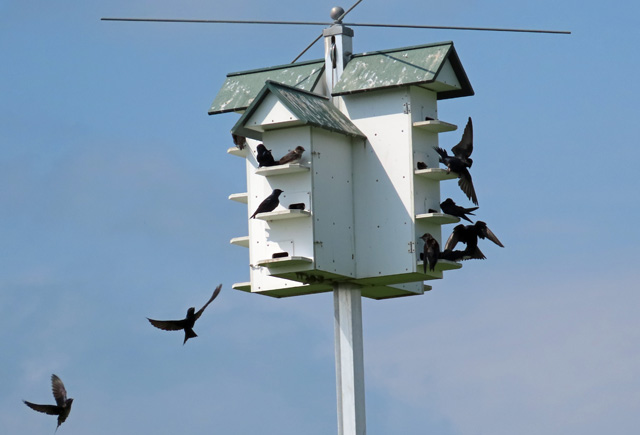
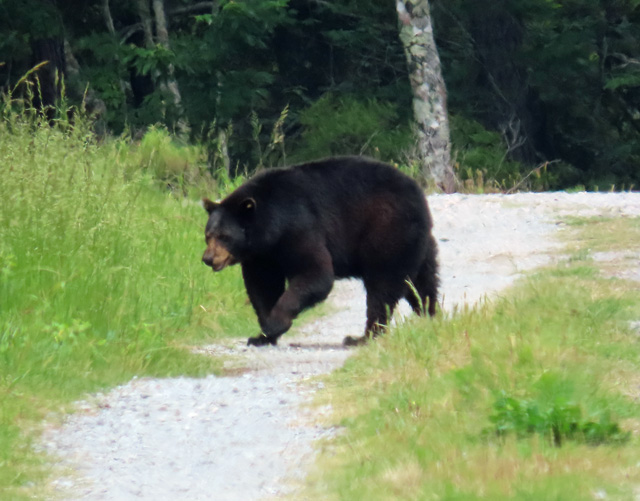
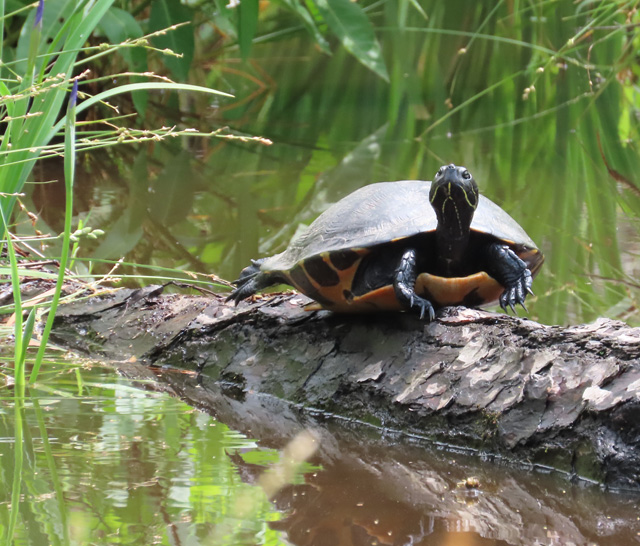

We are on a road trip to North Carolina for a week, visiting the Outer Banks. Here are a few shots from today:



At dog play group this week, while Ginger ran with her playmates, I watched Eastern Bluebirds and Tree Swallows compete for nesting sites. This rivalry is very common.
In one corner, we have a bluebird just getting ready to settle down.
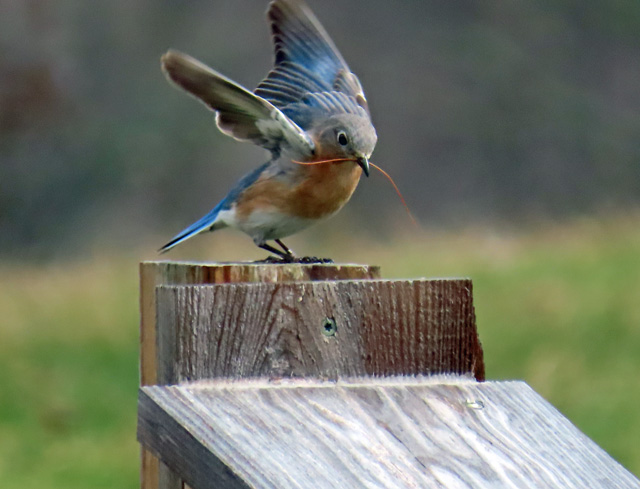
Also wearing blue is a pair of tree swallows looking for a domicile.
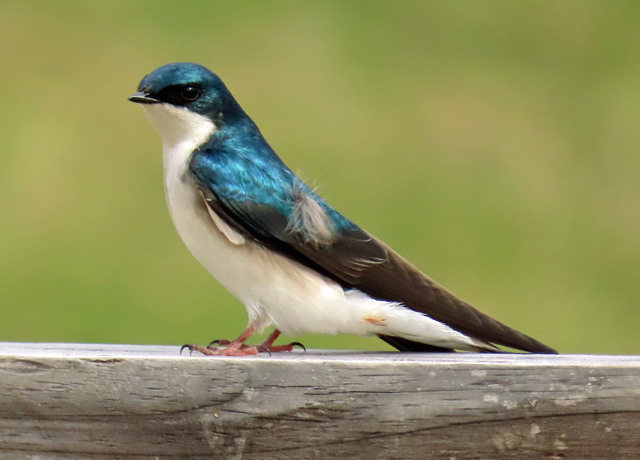
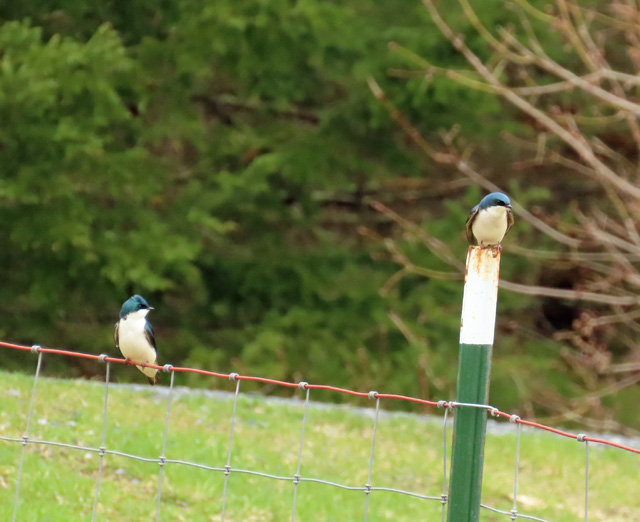
There seemed to be a lot of trash-talking going on.
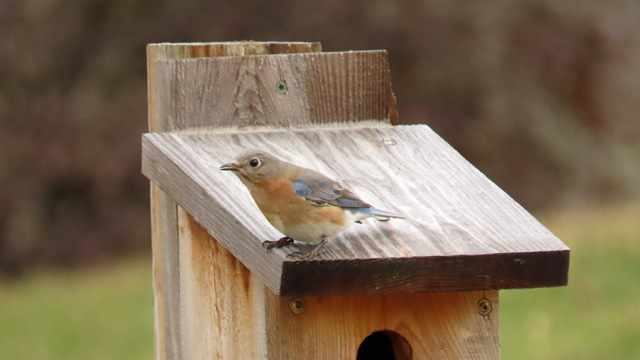
So, for about half an hour, I watched some aerial antics as the competitors went at it. My little camera caught some of the action.
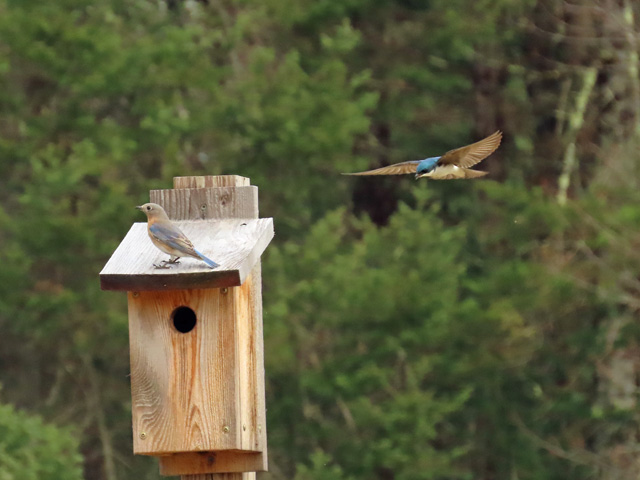
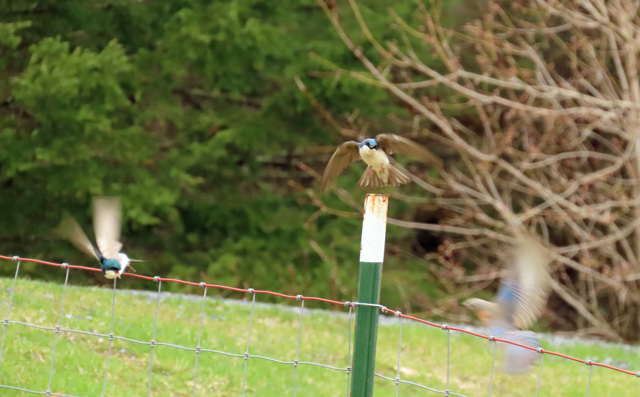
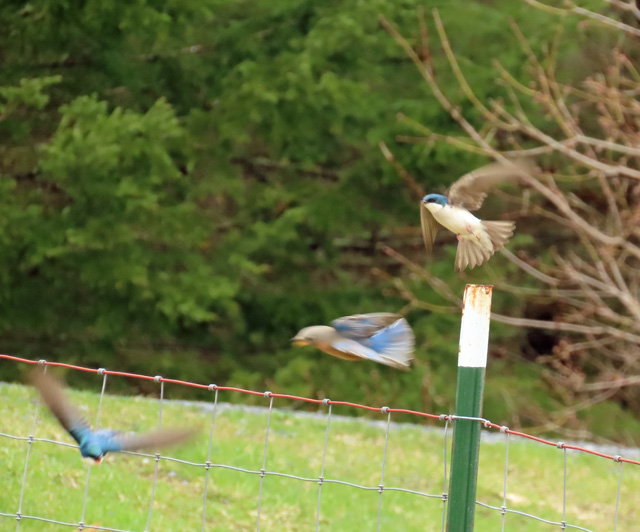
We’ll see, later this month, who ends up where — it seems like the swallows often win out but this bluebird was feisty.
The other day, I came upon a dozen turkeys having a little get-together. Normally super cautious, they sort of ignored me as they romped in the tall grass. Spring was in the air….
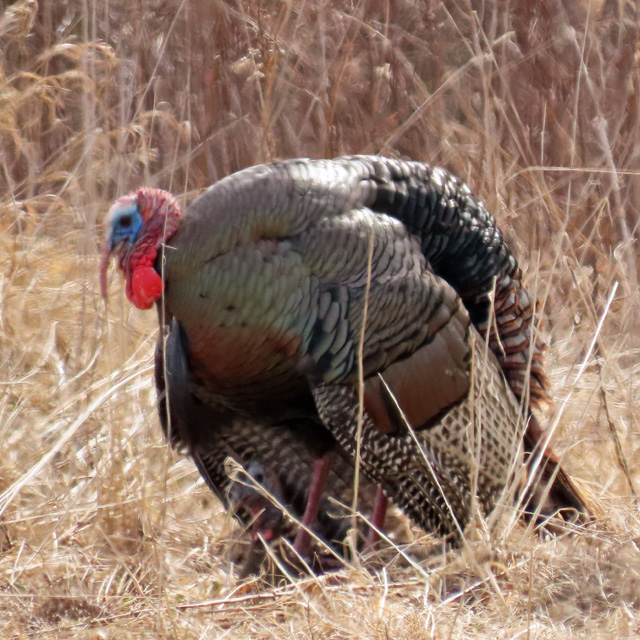
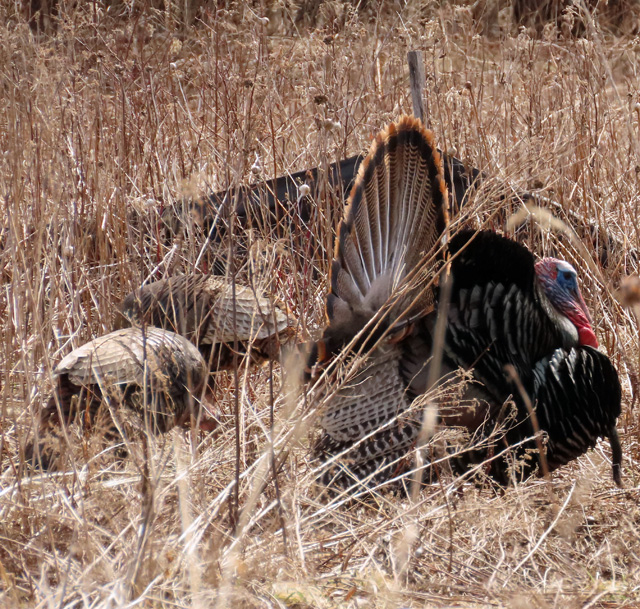
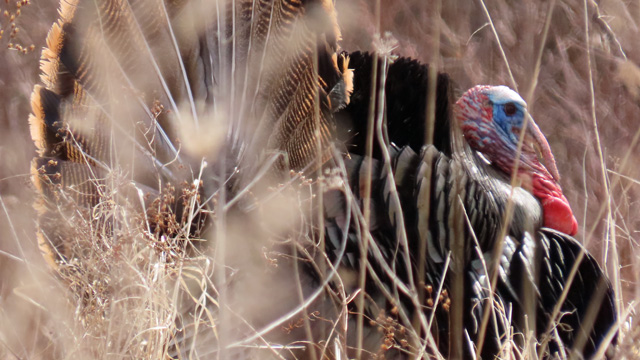
At the beginning of December, 2012, Gerry Cooperman posted a query on the MASSBIRD list serve in which he asked
“all that bird to take a moment to step back and look at why you do what you do. What was the spark that got you started?”
I was intrigued by Gerry’s questions and wrote to him asking to use his posting on my Vermont Birder blog. I figured that I’d use a few of the responses he might get as guest posts — bloggers are always looking for interesting content.
Little did I know, or did Gerry, that the next few weeks of postings would be full of individual stories from all over Massachusetts as well as other parts of the Northeast. Once I got started, I decided to keep plugging away and have ended up with over fifty “sparks.” There is a link off the blog header to get back to this summary.
I have put the links to each group. I only used first names of people but you can search for your name and should find the blog post in which your story was included.
Original Post Gerry Cooperman
Part 1 (Paul, Kathleen, David, Steve)
Part 2 (Catherine, Tom, Gerry, Jessica)
Part 3 (Doug, Stuart, Walt)
Part 4 (Dana, Dick H, Jim, Leslie, Fred)
Part 5 (Carolyn, Darin, Tom, Dee)
Part 6 (David, Sarah, Gian, Glenn)
Part 7 (Jean, Ann, John, Henry, David)
Part 8 (Jo-Anna, Kevin, Mike, Jim)
Part 9 (Lori, Jo-Dee, Amy, Greg, Mark)
Part 10 (Suzanne, Warren, Marjorie, Bruce)
Part 11 (Margie, Tim, CJ, Paul, Josh)
Part 12 (Denise, Myer, Jim, Linda)
Part 13 (Jeff, Michael, Dave)
Part 14 (Matt, Scott, Gerry)
This turned out to be a much bigger project than I expected but I, like many MASSBIRD readers, got hooked by the interesting diversity of people and stories. There are many themes — some being “starting early,” “mentoring,” rekindling the spark … I invite you to re-read these and see what you find. If nothing else, we’ve proved that MA has a lot of interesting birders who are good writers — and tell their story well.
There was some discussion of gathering these into some sort of collection. If someone is interested, go for it. Just be careful of the images — all are Creative Commons licensed and just need attribution. I know that some posts got lost in the shuffle but we did get 58 of them cleaned up and posted. They’ll be archived here for some time so feel free, when the birding is slow, to come back and read some. It was a privilege to work with your material. Dick
Here are some more posts from MASSBIRD describing birding “sparks.”
Matt began noticing birds early:
I’m not sure I actually have a spark; when I was 2 weeks old my mother’s journal contains a line “Birds and airplanes catch his attention more than anything else, he’s fascinated by them.” The airplane thing never took off .. I took my first flight earlier this year at the ripe old age of 30. The bird portion of that never faltered though.
Evening Grosbeaks were the first birds to catch Matt’s attention and also (below), Scott’s. photo by aurospio
My most vivid early memory of birds though was the Evening Grosbeaks that would visit a feeder we had attached to a window of our apartment, around the time I was 4. I’d get up early in the morning and the sun shining would cast the shadows of the Grosbeaks against the shade that was still closed. I would always peer around it, and they were so tame. Even with the shade up you could sit on the couch right in front of the window just inches away from these big boisterous yellow birds. I didn’t know they were an irruptive species at the time, they were so frequent in the first few winters of my life. I used to sit there for hours watching them feed on the plank of wood we had attached to the outside windowsill. I still remember the feeling of the window’s old pane of glass pressed up against my nose as I tried to get as close as I could to the birds.
Scott describes his “spark bird” and adds a thoughtful thank you:
My spark was the dreams of wanting to see an Ivory-billed Woodpecker in 1979. I started looking thru many bird magazines and books fascinated with this bird. That winter I had the best show of Evening Grosbeaks, dozens of them on my 2nd story platform bird feeders. Hooked!
However, if it weren’t for the wonderful guidance and friendship from Rodney Jenkins, who picked me up many a Sunday, I may not have continued birding. Rodney and I went on so many adventures and he really showed me how to find birds by truly shaking the bushes or rattling the trees so to speak, in search of the common species, and the elusive ones.
Scott has great memories of a large heron rookery in Phillipston. photo by mikebaird
One of my fondest memories is the day we found the Great Blue Heron Colony in Phillipston. We drove over this old road & that one, and into the deep woods of Phillipston in the area of the underground cable/electric lines. We were finally rewarded with 43 active nest out in a swamp near an old summer camp, it was so exciting! I also remember Rodney showing me my life Black-throated Blue Warbler near the heron Colony, of which I can still see that bird to this day.
Thank you Rodney
And we’ll end this series of post with a wrap-up by the birder who got it started, Gerry Cooperman:
To all who posted their spark tales I thank you for sharing part of your life with all of us. The stories were moving and poignant. You all contributed in making Massbird more than simply a sighting report. You have given Massbird a new voice. A voice not heard before and what you do now to make that voice stronger will define who we are. But more importantly it will pass on our stories to a new generation. As we were given the spark along the birding way we were also given lessons. Lessons that would mold us in action and deeds. It is not just about the birds. Pete Dunne stated in one of his books that if you are a dedicated birder and don’t write about it you are depriving many of something very special. The stories keep generating the sparks. Do not deprive anyone.
My spark that was started in July of 1970 was a mere ember. Slowly gaining strength over time as experience and education began to slowly fan that smoldering ember until it grew into a flame. A flame that would define my life as an individual. In life as you mature there are significant moments. Lesson moments , if you will, that will define your character and how you appreciate all the people and moments. It’s not always just about the birds but sometimes we are so focused on that that we lose sight of all that is important around us. We get caught up in the moment. Hubris becomes our friend and that makes us someone different. The lessons learned are really moments of awareness. They become the building blocks of our character.
Allow me to share with you one of these memorable moments. A moment that taught me a lesson and helped mold me as a person.
I was getting jaded as my job took me to many key bird states: California, Texas,Washington, and Florida, and I somehow always had a weekend of free time. Spending time at Salton Sea, Palm Springs, El Paso, the Everglades, and the Keys. New places, new birds, Hey! this is real easy. Never once did I think about how fortunate I was. And of course doing anything that was some what unusual made other people very curious. People wanted to know what you saw, show it to me in a book,and where have you’ve been? It can make you feel important; of course in a mind of one. Without being aware you start to lose perspective on what’s really important. It’s so easy to look into a one way mirror.
I was about to receive my lesson ( unknown to me of course) as I was off to the ABA convention in Tucson. After clearing baggage I was directed to a station wagon and wound up in the last row. We get under way and someone in front yells out,”what states are you from?” The only thing I remember was that one of the three men in front of me says Maryland and when it’s my turn I say Massachusetts. The Maryland voice says,” I used to live in Massachusetts” and turns around extending his hand and says ” Hi I’m Chan Robbins.”
From day one, as a beginning birder, I have always used the Golden Field Guide and now I’m holding his hand. Hopefully he didn’t see the dumb look on my face as I was trying to say some thing really intelligent. What came out was,” Hi! I use your book.” Gosh wasn’t that brilliant? To which he replied with a grin ,”don’t tell anyone but so do I.” He thanked me and what struck me was his kindness to even engage in a conversation with me. He was interested in talking to me and it was sincere. I never even gave him my name and if he was sitting next to me I probably wouldn’t have released his hand. This was the beginning of my lesson.
The second day out we happened to be on the same field trip. He acknowledged me with a simple ,” Do you have my book today?” He remembered me probably because of my inane utterance. I told him it is always with me. He smiled and nodded a silent approval. Now we head for our destination. We were going up a hillside when the leader calls out Buff-breasted Flycatcher. Certainly a new bird for me and to my surprise a lifer for Chan Robbins. He was so excited he literally jumped up and down for joy. He did not care that there was a group of birders watching him. He was appreciating the moment. It was a special moment in his life and he was celebrating the event. He was Chan Robbins the birder nothing more nothing less.Here was a man at the pinnacle of the birding world acting like most anyone who gets excited upon seeing a new bird. Doesn’t everyone? I realized he could have kept quiet and nobody would know but this man was genuine. He knew who he was as a person. His appreciation of the moment magnified his excitement. He was also excited about seeing birds again that he hadn’t seen in a little while and he made it known. It was like old friends meeting once more. My early mentor was right, appreciate what you see now because you never know when you will see it again. It wasn’t just about special birds it was about all birds. I have never forgotten our encounter and the special moment of self awareness that I learned.The lesson was now complete.
Be yourself – everyone else is taken. Never allow any deed make you somebody else in life. I appreciate and respect the accomplishments of others but have a difficult time in understanding why being humble and gracious takes too much time or effort for a lot of people I’m not quite sure why! A long time ago I was as guilty as anyone.Is being true to yourself so difficult?
It’s never just about the number of birds you’ve seen or about the places you’ve been or about the people you know. It’s not about any measurable or material things. It’s always just about you and who you really are as a person. A person with a special gift as a carrier of the flame. When you truly know who you are and pass the spark to others the flame burns the brightest. A Golden Field Guide is always out and laying flat on my bookcase as a constant reminder of the lesson. And, most important, the man.
Your spark stories tell me that someone was gracious and kind to you. Their station or status in life was unimportant. Their focus was you. You will pass the spark on to others and always remember what was done for you. Hopefully you will always keep in your hearts and minds the special life lessons given to you. It’s never ever been just about the birds. It is always about how you live your life. Thank you Mr. Robbins.
Initial Post Responses: Part 1 Part 2 Part 3 Part 4 Part 5 Part 6 Part 7 Part 8 Part 9 Part 10 Part 11 Part 12 Part 13
Sign up by RSS feed or via email to have future articles sent to you.
Jeff recalls hand-feeding chopped walnut meats to a Black-capped Chickadee:
I didn’t have a spark per se but rather more of a constantly fed comfortable fire. My father was already a “bird-watcher” when I was born 65 years ago. There were always feeders in the yard every winter and I remember being impressed and thrilled when there were invasions of siskins,
Evening Grosbeaks and other special birds. All through my childhood, my father and I would take walks in the woods, often at Fannie Stebbins Refuge in Longmeadow or Forest Park in Springfield and would look for anything that caught our eye when it came to nature. We also fished a lot and hunted some (I don’t remember ever killing anything.) so these also usually turned into nature trips. We went to the beach a lot in the summer and always stopped to check out the waders and shorebirds in the salt marshes.
There was a small patch of “woods” near my house and my friends and I would spend hours playing and exploring this area. I remember one day finding three young Screech Owls sitting next to each other on a low branch and running home to get my Brownie camera to take their picture. None of this seemed unusual to me and I figured that every kid grew up with as much exposure to nature as I had. I have since learned that this was not the case and I treasure all the times I spent with my father and friends in the woods that gave me such an appreciation of nature.
One of Jeff’s fondest memories was of one particular Chickadee that would fly to him whenever he walked out of the house. photo by juicyverve
As I grew older, other things like girls, college, the army, and jobs took precedence over birds and my birding activity fluctuated. My father continued with his interest and actually became president of the Allen Bird Club in Springfield for a while in the ’60s. I was lucky enough to marry a woman who also had an interest in birds and we spent many years rekindling our mutual interests. We lived in the woods and it was here where I first started feeding Chickadees and Nuthatches by hand. I used chopped walnuts and the birds loved them. One of my fondest memories was of one particular Chickadee that would fly to me whenever I walked out of the house. I even got in the habit of keeping some walnuts in my pocket to feed him(?) whenever he came to me. He had me well trained. He could even pick me out of a group of people. One summer day, my in-laws were at our house for a picnic and as the eight of us were sitting at the picnic table, the Chickadee flew over and landed on my shoulder. As my in-laws looked on in amazement, I reached in my pocket and pulled out some walnuts which he quickly grabbed and flew off. He often came back for seconds, so I gave some walnuts to my mother-in-law and told her to hold her hand out. Sure enough, he came back, landed on my shoulder for a second, and then right to her hand to grab his treat. He was around for about a year and a half and always made me happy. My wife and I eventually split up, but I’ve never lost my affection for Chickadees and still feed them by hand.
I love birding and seeing rare species, but I get just as much enjoyment from watching everyday birds going about their everyday activities. They still amaze me and every time I come across something that reminds me of things my father and I did, the fire is rekindled. I still have the first Peterson Guide my father and I used and it has a special place on my bookcase.
A homemade bird feeder launched Michael into birding:
My initiation into the ranks of birding began at the age of 12 with a Christmas gift: a jigsaw. My first project: a bird feeder. I still have a Polaroid snapshot of that crude attempt at carpentry, mounted on a pole in the snow outside the kitchen window. Within a day or two it had been discovered by some jays and chickadees, to be followed by other common denizens of the New England winter. As the snow melted in the spring, the feeder fell over, and I had to prop it up with cement blocks until the ground thawed and a proper hole for the post could be dug. That feeder served a good five years, and opened up a whole new world to me, a world that would come to include travel and friends and countless pleasurable hours based on birds and birding.
Blue Jays discovered Michael’s feeder at once. photo by thefixer
My second project, a bird house, only served to confirm and strengthen my new-found interest when a pair of tree swallows claimed it that April. That house, another crude product of scrap lumber and the jigsaw, probably stood five or six years, and every year produced a brood of tree swallows, and I also have a snapshot of that house with that first pair of swallows perched atop. Sometimes a gift can be a gift of another sort in disguise, and you can never tell where those ribbons and wrapping paper will lead.
The spark that turned Dave into a birder was the Blizzard of 1978:
My parents were outdoors people and passed their joy and appreciation of the out of doors on to their children. Our vacations were camping trips. We camped on the Cape, the White Mountains, Canada, and even had a 3 week camping trip across the country.
My father and I fished a great deal. We spent many hours walking the streams and rivers of New Hampshire. We went crabbing for Blue crabs in the tidal marshes and rivers of the South Cape area and fished for Stripers throughout the south side of the Cape. My parents also kept bird feeders. I can remember them sending in a post card to MA Audubon when they saw a Cardinal. My next memory of birds was when I was in high school and a flock of Redpolls came to the feeders for several days.
Ringed-neck Pheasant tracks sparked Dave’s interest. photo by USFWS
The spark that turned me into a birder though, was the Blizzard of ’78. My wife and I had an apartment in Danvers and the property behind it was open area that ended up along a small, tidal river. After a couple of house-bound days, I went out for a walk through this area and came upon a set of tracks. They were Ring-neck pheasant tracks. I followed these tracks for quite a ways until I came to where it roosted during the night, in the lee of the wind behind a big, carved out rock. As the winter unfolded, I continued going out on these treks looking for this bird. I often heard it in the morning heading off to work, but never saw it until the Spring. I continued these walks throughout the winter and into the spring. I’d go down to the tidal river at dusk and hunker down and watch the Black ducks fly in. I also got to observe a Great blue heron hunting. One day I stopped into the Reading Public Library to check out a couple of books on birds. The librarian struck up a conversation with me about birds and it was clear she had a passion for them. The librarian, Anne Blaisdell, told me about the Brookline Bird Club, of which she was a member. I went on several walks with the BBC and greatly enjoyed the new areas, birds, and people I met. The hook was set and I became a birder for life.
As an elementary and middle school science teacher for 36 years, I had the opportunity to share my passion of birds with my students. I used birds as the vehicle to teach observational skills to my students. For 32 years I took my students to Plum Island as part of our study on bird migration.
Birding is a joy! It can be done anywhere, any time, and on any scale you want.
Initial Post Responses: Part 1 Part 2 Part 3 Part 4 Part 5 Part 6 Part 7 Part 8 Part 9 Part 10 Part 11 Part 12
Join those who comment on what spark set them on their birding journey? Tell us about it with a comment below. You should sign up by RSS feed or via email to have future “spark” articles sent to you. Thanks
A fallout of warblers sparked Denise’s love of birding:
What sparked my interest in birding back in the 1960’s was an awesome outfall of “sparks”, the springtime jewelry of migrating warblers in our beautifully flowering antique apple trees in Lynnfield. We were lucky enough to have an overly large lot that included about a dozen full-size Baldwin and Macintosh apple trees, and in the spring of 1965, they exploded in bloom just as clouds of gorgeous warblers migrated up to feed on their pests. I had always been the child who wanted to stop the car to look at hawks and ducks, but the warblers just blew me away. It’s a good thing I could ride my bike to the library, and that my grandfather gave me his old hunting binoculars, because there was no stopping me after that.
Migrating warblers were Denise’s “shower of sparks” birds. photo by jeffreyw
My only regret is that we only had one car, so I had little access to the birding community. No mentors, no one to help me learn that a Junco in Massachusetts in June is cool, but common in December. I finally got my license, and my own car, so I could join the BBC and pick up on the finer points.
Myer was hooked as a youth by the activities at the Boston Museum of Science:
I have always been interested in nature, and in my adolescence I Joined the Museum of Science in Boston. I went on field trips, was a Junior entomologist, and became a Junior volunteer in their animal room. I guess what started birding was that one of the adult leaders would take the volunteers out to Mount Auburn Cemetery, where we would identify birds. I remember being on the dock at the Museum of Science and a Great Black-backed Gull landed on the dock, and got everybody excited since at that time the Great Black-backed Gull was a rarity.
A “rare-at-the-time” Great Black-backed Gull was on of Myer’s early spark birds. photo by Dendroica cerulea
I continued on an off birding from many years and then took a course that Mass Audubon and Wayne Peterson presented on beginning birding and have continued birding since then. My interest in the photography side of birding began with a course that the Cornell Living Bird Laboratory had on bird photography.
Since I have retired, I have been fulfilling my passions, for both photography and birding.
After several birding sparks over the years, a dog got Jim serious about birding:
First notice: I spotted a Blackburnian Warbler high in the ash tree across from my house in Nahant. I was about 20, and open to all kinds of new experiences. I didn’t pursue it, but was observant and noticed birds with heightened attention.
Second: Camping in Morro Bay, CA. in 1977. My ex-in-laws were all excited about the great blue heron rookery in the Eucalyptus trees. It was impressive. Having moved from Nahant, MA to California, I was flooded with new experiences. Birds were a part of that – magpies, thrashers, road runners, kites, dippers – all “early birds” for me thanks to California.Then a long hiatus while I raised a family and life happened.
Third: In 2007 we rescued a 9-year-old dog around Christmas time. I started taking notice of the ocean ducks on our walks. The dog was old, slow and very patient, and a wonderful casual birding companion. (Some North Shore Massbirders will remember her.) I figured that if I was going to be out in this crummy weather at least 3 times a day, I might as well have a “project:” learn about those ducks. I did, slowly but surely. By January 2009 I was really into it. One Sunday, I joined Bob Mayer for a Jamaica Pond walk. Afterwards, I took the dog for a walk when we spotted a Common Shelduck off Little Nahant. The subsequent reaction of the birding community was revelatory, and fun!
Interestingly, for me, as a musician as well, many memories are linked to either birds or music. In the way a song can evoke not just a memory, but a full sensory experience of a lost time and place, many life milestones are intertwined with my memory of birds: seeing a golden eagle through a sunroof, while driving through South Dakota on my way to a new life in California; that first Blackburnian; watching the pelicans dive at Avila Beach as an undergrad with a beach-friendly schedule at Cal Poly SLO; the red-headed woodpecker at the Lake Michigan campground where I camped on yet another cross-country trip; the meadowlarks and yellow-headed blackbirds singing as I drove through the Midwest on my way home.
A warbler fallout also sparked Linda’s interest in birding:
My fascination with birds began with a sudden and powerful spark. As a young child I was always interested in animals, bringing home all kinds of stray critters or injured birds. However, being a city kid, the birds I saw were mainly pigeons and house sparrows.
The Spark that ignited my love of birds happened when I was in my early 20’s. I had decided to plant a garden at my parents new home in Chelsea. The house was located on the side of a steep hill, called Powder Horn Hill. One lovely spring day I was working in the garden and stopped to rest. I sat on the top of the hillside overlooking some trees and shrubs. Wow! Right before me was a “warbler fallout” at eye level. What were these gorgeous colorful gems moving about in the leaves? I never knew such beautiful birds existed. And they were singing. I dashed to the local drugstore and bought a Golden Guide to birds. I returned to the hillside with the book and my parents old binoculars. Finally, I matched a bird with a picture! It had a name. I actually knew it was a Black-throated Blue Warbler. Incredible. What a great feeling. I went on to identify another and another. I looked through the book – there were so many birds. How could I find them? That was the beginning of a new lifetime passion – learning about birds and the miracle of migration.
A Black-throated Blue Warbler was one of the first birds Linda identified by herself. photo by dickmfield
For the next few years I birded alone since I didn’t know any birders and wasn’t sure that many people actually watched birds. I birded whenever I could, but at that stage of my life, much of my non-working time was spent socializing. It wasn’t until I was a stay-at-home mom, raising my new son, that I decided to find other “bird people”. What a great community! I love sharing the joys of birding and the fun and excitement of a quest. I also still love birding alone: I can wander, listen quietly and track down a song. Admire a bird for as long as I wish.
Birding has led me to many fascinating places in the world to see incredible birds. I also continue to find great rewards here in the northeast, where migration provides an ever-changing show. When I come upon a familiar migrant species for the first time each season I find myself actually smiling and with a sense of relief, I think “Hi, it’s you. So glad you’re back.” So many great memories.
Initial Post Responses: Part 1 Part 2 Part 3 Part 4 Part 5 Part 6 Part 7 Part 8 Part 9 Part 10 Part 11
Join those who comment on what spark set them on their birding journey? Tell us about it with a comment below. You should sign up by RSS feed or via email to have future “spark” articles sent to you. Thanks
Harry, the chaffinch, provided the BIG spark for Margie:
I have two sparks–the first being then five year old Jason who received a field guide for a holiday gift . At the suggestion of my aunt, we began taking him on BBC walks/trips which I also enjoyed, for seeing birds, learning the names of the common birds, but probably even more so, for the social nature of the birding walks. I would mostly rely on Jason or others to tell me what we were seeing.
But the BIG spark came when we had a chaffinch arrive in our yard three years ago. It was early morning Dec.1st, and Jason was leaving for work. He came running back into the house, pulled out a European field guide, and told us to watch for a bird that looked something like a house finch, and call him if we saw it, which we did. Early the next morning we had our first three visitors –Jason wanted confirmation in case the bird only stayed a day or so. (Little did we know that we would be hosting this visitor for three months!)
Harry, as we called the bird, was not the actual spark–it was having so many people over the next month or two spend time in our kitchen enjoying what was for many a life bird. Listening to all the conversation going on gave me a whole new vocabulary and made me so much more aware of ways to really “see” and appreciate birds.
While I often still rely on Jason and others to tell me what I am looking at, I now know all our yard birds and most of the common birds local birds, and will use a field guide to try to figure out what something I don’t immediately recognize is.
By the way, the Post-Its I used to note visitors and Harry sightings are still on the wall in my kitchen!
A Google search for Ivory-billed Woodpecker rekindled Tim’s birding passion:
A little background first. I was interested in birds from age 6 to 9 and then totally and completely forgot about them until I was in my early 30s. Now I look back and wonder how I ever survived those middle years.
I grew up in southwestern Ohio, and at the time did not know that a raptor rehab center was a rare thing. My father would take me (along with my older brother) up there at times. On one of the trips, we stopped by the associated nature center on the way home. They had a nice feeder setup, including a big suet block; all of this was visible from the warmth of the visitor center. I was just shy of 8 years old at the time, and had already plowed my way through the Golden field guide. The two largest American woodpeckers had interested me for some reason or another, and I had memorized their paintings and descriptions. When the guy running the center asked me my favorite bird, I said “Ivory-billed Woodpecker”. He informed me that he got Pileated Woodpeckers on occasion, and then said “well here he comes now”. I found myself within a few feet (glass in between) of a stunning male Pileated Woodpecker chowing down on the suet. He was big, bold, and magnificent, and seemed as big as I was. I have never forgotten this moment. And when I see a Pileated, I stop and admire them. And it is easy to get transported back to the winter of 77/78.
Tim has had a long-time interest in Ivory-billed and Pileated Woodpeckers. photo by hyperion327
The “spark” that got me back into birds was very simple. For nearly 20 years I was an observational astronomer, meaning that I spent at least a few nights a month on the all-night shift. As anyone that has done night shifts knows, you’ll do ANYTHING to stay awake and defeat the tedium. For some reason, I threw “Ivory-billed Woodpecker” in the google search bar in the winter of 2001/2002, and wondered what had ever happened with these birds. And that was all it took. My love of birds resurfaced in my early 30s, and it still retained a lot of the joy and intensity I thought only a youngster could feel. To this day there are still birds that will make my knees shake when I see them (like the Connecticut Warbler Brian Harris and I saw this fall in Wayland), and some, like the Plymouth Ivory Gull a few years back, and nearly bring me to tears.
CJ summed up his three sparks:
1) My grandfather was a forester in Pennsylvania. He had two huge posters in his kitchen – one the Birds of Pennsylvania, the other Pennsylvania Birds of Prey. I would gawk at them for hours when I was small.
2) Eight years old and walking down a backwoods road with friends. I was making crow noises. We were attacked by a red-tailed hawk.
3) Took an ornithology course at Allegheny College. On a field trip to Erie National Wildlife Refuge the bus was going through the grounds of the refuge. A huge creature took to the air – I managed to stammer out something about a Big Bird. It was a Great Blue Heron. It was all over after that.
Paul thinks that he may have started birding before birth:
Not sure this had anything to do with it but in 1968 my (expecting) mother sat in our tree and bush-filled yard just north of Detroit and watched birds from her chair while my sisters played. Can you start birding BEFORE you were born?
As a kid I remember putting up small sticks near tern and plover nests as warnings to cars and beach-goers along the Race Point and Long Point shoreline during summers on Cape Cod (guess it didn’t work that well).
I have a photo of me when I was 8, Chickadee perched on fingertip ready to pluck a sunflower seed. I remember thinking how rare and exciting it was to have both species of nuthatch come down to snag a treat. I think that photo comes close to “the moment”.
Paul recalls hand-feeding Chickadees at age 8. photo by Dawn Huczek
When I was 10 I dug the condenser mic from my inherited boom box and mounted it on an arm extending from a wok cover… a perfect parabolic mic. I remember how incessantly the Tennesee Warblers sang from the canopy, how aggressive the Ruby-crowned Kinglets and House Wrens sang and scolded at playback, and how complex the song of the rare Canada Warbler was when the odd one would happened through the undergrowth.
Sure would be nice to make a living at that kind of stuff.
Josh details three sparks on his pathway to birding:
#1 was when I was probably 2 or 3 years old, then living in Peabody. My father grew a backyard garden including a little patch of corn. His corn would get raided by Ring-necked Pheasants. The male pheasants just blew my little mind. I have been all about nature ever since.
#2 was several years later. I talked my father into taking me to a Mass Audubon field trip visiting Plum Island in May. It was my first real taste of hard-core neotropical songbird migration, with warblers, vireos, tanagers, orioles, etc. The one bird that really stands out in my memory from that day was the Canada Warbler.
Josh remembers a Canada Warbler as a standout bird on a memorable Plum Island visit. photo by Jeremy Meyer
#3 was around the same time (may have actually taken place before #2, my memory of the chronology is a bit hazy). But it was not a bird, it was a person. My school had a weekly extracurricular activity period. Different teachers offered different activities and students signed up for their favorites. I was the only student who signed up for bird-watching. Leading this activity was the school’s Latin teacher, Barbara Drummond. A few of you might know her. That activity period introduced me to birding clubs, hot-spots, listing, all of the social, recreational, and informational framework that birders have built up in conjunction with this activity that we do. From that point on, birds eclipsed other interests and organisms. Abandon all hope, ye who enter.
A few years after that, in high school, I took an ornithology class from yet another Latin teacher, that one named Tom Burgess. Birding and Latin must go together on some level.
Initial Post Responses: Part 1 Part 2 Part 3 Part 4 Part 5 Part 6 Part 7 Part 8 Part 9 Part 10
Join those who comment on what spark set them on their birding journey? Tell us about it with a comment below. You should sign up by RSS feed or via email to have future “spark” articles sent to you. Thanks
House Sparrows sparked Suzanne’s interest in birding:
This year is the first time since I moved to Wilmington, 23 years, that I have had a flock of House Sparrows at my feeders. When I walk out of the house and hear the group singing I feel a little melancholy and memories, some good, some bad come back. I was thinking about this very subject a few weeks ago when they showed up. A sign maybe I thought? Has my life come full circle?
On Chatham St. in Lynn where I grew up , there wasn’t any birds singing but House Sparrows. They use to sing in the bushes under my window next to the caterers. I was a wicked tom boy, always dirty, loved being outside, and played various sports with my brothers and their friends. I would often get distracted by the House Sparrows, and of course my brother Billy would tease me.
“So the next time one might think to “hate” those House Sparrows, try to remember that they might just give a spark to a poor city kid where no other birds besides pigeons reside.” photo by Pets4Dawn
We lived in a decrepit house, surrounded by commercial development on a small lot with a mostly dirt backyard. For a not so “normal” poor kid in the city who loved nature, House Sparrows to me were hard not to notice with their loud explosive song and their obsession with dirt baths. I use to love to check out the depressions and wing marks they left in the dirt. They were so cute the way they fluffed their feathers, hopped around. Sometimes I would feel badly because our run-down (a.k.a. pickle) game would keep them away. I eventually set up a bird bath with a pie plate and a bleach bottle filled with water with a small hole so the water would drip out slowly. I hung it in the one of the only trees in the yard. They loved it! And I loved that they loved it.
My beloved mother fostered my interest in birds. She took me places like Plum Island, Ipswich River Sanctuary, and worked a community garden at Danvers State Hospital. Santa left me field guides which I would look at and dream about seeing birds like Bald Eagles, and Scarlet Tanagers. I was obsessed with animals and birds. I had a tricycle I pretended was Black Beauty, strange huh? Lassie, Tarzan, and the Mutual of Omaha Wild Kingdom were my favorite TV shows (Did I just date myself? ). When I got older I wrote my reports on Life Sciences, Ornithology, and Jane Goodall, one of my heroes. I knew I was very different from any of the other kids. I started a life list and started adding on birds I use to dream about seeing, but never told my friends.
Then I became a teenager. I hated bullies. I felt had to “toughen up” if I were to survive. I got away from birds and nature. The angry at the world teenager doesn’t bird watch, they work on attitude and smoke cigarettes. When I decide to do something I try to be good at it, I found being tough was easy, but didn’t make me happy. There is a whole lot of chapters in between but I survived and grew up. I never turned into a Jane Goodall but I did make it to Alaska to study Bald Eagles with the School for Field Studies. I was asked to come back as an intern but decided to have a family instead. My tough thick skinned training came in handy working on controversial environmental issues so I wouldn’t change anything. The kids are older and I have found my way back again to where I belong. It took me almost a life time and why I enjoy and appreciate every minute of being out there. So the next time one might think to “hate” those House Sparrows, try to remember that they might just give a spark to a poor city kid where no other birds besides pigeons reside. And remember, there aren’t too many House Sparrows, there are too many people.
An upside-down Baltimore Oriole sparked Warren’s love of birding:
I was very fortunate to grow up in a small town (West Newbury) where the woods, fields, and wetlands were pretty much out my back and/or front door. I also have a father that has interests in astronomy, geology, and ornithology. (He is now 88, and still in the same house) He would take me on mini birding trips on the dirt roads in town when I was about 7 or 8 years old in the mid 1960’s. The “spark” came one day in the backyard when he had his home made telescope out and set up to look at the moon one day and got on a Baltimore Oriole that was nesting in our long-gone American Elm. I was floored, and hooked. It was also when I realized that astronomy telescopes portray the image upside down, so the Oriole flew up into a nest that defied gravity!
A Baltimore Oriole, seen inverted in a telescope, was Warren’s spark. photo by davedehetre
The next spark was when my folks bought me the rather large, double-volume National Geographic bird books. Some of you might remember this set. I had bendable plastic records in the back of the book that could be folded, like a book, and played on a record player (remember those?) Well, all this did was expand my knowledge of what birds were out there since the books covered the entire US, and not just the east. I wanted to see them all.
Soon I was leaving my poor dad in the dust, and he was dropping me off at the Plum Island airport at 12 years old to meet the Brookline Bird Club and I’d spend the day with them birding the area.
This is when I met a young teacher from Haverhill, who would pick me up at the end of my street frequently, and bring me home when my dad wasn’t available. His name was Bill Drummond. Thanks for the rides Bill!
My birding might have taken a back seat for awhile to sports, cars, and girlfriends, but it never left me. Now I enjoy it more then ever-it’s my stress relief and anti-drug! I’m thankful for it.
Warblers galore at Hellcat sparked Marjorie:
Although I grew up in CT, all of my siblings and I were born in Maine and we spent every summer and major holidays at my grandparents farm in Lincolnville, Maine. My grandparents always fed the birds and I remember the flocks of Evenings Grosbeaks and Blue Jays, seeing the Great Blue Heron spearing minnows at the farm pond, watching the Bobolinks in the field, listening to the haunting call of the Common Loons when we stayed at Winnie’s camp on Levenselar Pond. My Dad often took us for long walks in the woods or trout fishing, affording us looks at new birds and other wildlife like beaver, muskrats and mink. My first bird field guide was a birthday gift from my older sister in 1969 – Peterson’s 2nd edition “A Field Guide to the Birds”. I started keeping a small life list in that book. While the spark was always there, birdwatching was something I did once in a while. When I married, we had our own bird feeders and I would go birding with my sister Annie at Plum Island from time to time when she visited Massachusetts.
I would say the flame was really lit in May 1996 when I birded with Annie at Hellcat on Plum Island. There was a warbler fall out that beautiful spring day. The warblers were at eye level, and seemed to be everywhere, landing in front of us and even sitting on the Hellcat board walk itself. Warblers up close was new to me and I kept saying – what kind is that? how about that one?, so anxious to see each one and try to figure out its name. I was definitely hooked and wanted more.
Warblers on Plum Island were Marjorie’s spark birds. photo by Dendroica cerulean
I started participating in some of the Bird Watchers Supply & Gift bird walks, led by Steve Grinley. I joined the Brookline Bird Club and often went on local trips led by Bill Drummond and many others. I took the North Shore Ornithology course taught by Steve Haydock. While I still consider myself a mediocre birder compared to so many more experienced birders I have met, it is the knowledge of those people that has helped me to grow and learn. I would like to thank everyone who has pointed out a bird to me, shared their scope with me, helped me to learn a new bird song, etc. I have so much more to learn and see and I look forward to what new adventure awaits me every time I go out birding. Its like a treasure hunt – you never know what you will find!
While my own children, now age 24 and 27 are not birders yet – they do notice the birds and often describe some bird that they have seen. Their spark is still hiding within – but I have hope that their flame will someday be lit as well. In the meantime, I am lucky to share the birding passion with my four siblings, Annie, Lee, Margaret & Janet. We get together as much as possible to go birding. I am the only one in Massachusetts, 2 live in Maine and my brother is in Indiana. While most of our bird trips are informal get togethers, occasionally we have gone on organized bird trips together. All five of us went together to Colorado for the Grouse Grand Slam with Bill Drummond, we went to Baxter State Park with Bob Duchesne and we look forward to a trip to Texas soon. My mom, now 86 years old, still lives at her parents farm in Lincolnville and she is still feeding the birds. I only wish my Dad were still here to go with all of us on a birding trip. He would have been pleased to know how much his walks in the woods meant.
Remember, to share your passion with others, share your scope with a non-birder who asks what are you looking at – you never know when YOU will be the spark that started the passion for someone else.
Hooded Mergansers sparked Bruce’s birding into high gear:
I’ve been enchanted and moved by all things natural since my childhood summers with my family in Rocky Mountain National Park. I remember especially loving the hummingbirds at my grandparent’s feeders.
When I spent several years traveling around Latin America during time off from college, I always had a compact pair of binoculars with me. When I met my wife Mary, we discovered we both liked birds. We had both taken an ornithology class in college. When we took the kids on two extended tours of the western US in rented RVs, we decided we needed two pairs of binoculars so we wouldn’t have to keep fighting over them, and we even bought a field guide. When my daughter was eight years old, she and I spent many dark winter evenings wandering through the woods behind our home trying to get a look at the Great Horned Owl who’s call was enchanting us so, and that was waking my wife and I at 5 AM from its roost outside our bedroom window. Whenever we saw an unusual bird, or the time we watched a raptor in our backyard eating its bloody prey during a snowstorm out our back window, we’d pull out our field guide and leaf through, trying to figure out what is that bird anyway (rarely successfully – we had no notion of field marks).
After the kids left we downsized to a home on Pelham Island Road in Sudbury and started noticing people wandering around our neighborhood looking at birds. On January 15, 2009, I was crossing the Sudbury River on my way to work and spotted some unusual looking ducks. I happened to have binoculars in the car, so I stopped to take a look. I was shocked, dumbfounded by their beauty. I called my wife at work to tell her about them, and spent the morning at my office on the Internet trying to identify them, before finally deciding they must be Hooded Mergansers. I couldn’t think of much else all day.
Hoodies continue to captivate Bruce. photo by quinet
That evening Mary and I decided: OK, we have got to start learning what these birds are. We went on-line and started signing up for outings and classes at Drumlin Farm. Four years later, after about 70 Mass Audubon group outings, birding trips to Texas, Oklahoma, Maine, NH, and Pennsylvania, taking the Birder’s Certificate Program at Joppa Flats, and countless hours birding by myself or with my wife, with a new and wonderful shared joy in our marriage and dozens of new friends who share our new passion, I have dozens of standout bird memories – a solitary Wood Thrush calling in the darkening evening in Griscom Woods down the road from our house, the Eared Grebe in full breeding glory 10 feet away in the dawn mist in Oklahoma, hundreds of White Pelicans circling high and silently in the bright sun, or watching Torrent Ducks plunging and bobbing as we ate breakfast by a roaring river in Peru. I’ve learned there is not one, not two, but dozens of kind of ducks. And of course I’ve seen hundreds and hundreds of Hooded Mergansers. But they still take my breath away every time. Last weekend, after a delightful day on the south shore and cape with Strickland Wheelock and friends, 63 species for the day and adding Northern Lapwing and Little Egret to my life list (numbers 474 and 475), the most memorable moment was the single Hooded Merganser filling my scope at Marston Millpond.
Initial Post Responses: Part 1 Part 2 Part 3 Part 4 Part 5 Part 6 Part 7 Part 8 Part 9
Join those who comment on what spark set them on their birding journey? Tell us about it with a comment below. You should sign up by RSS feed or via email to have future “spark” articles sent to you. Thanks
New birder Lori had no idea the spark was in fact a spark:
It was January 28, 2010, and I was driving down Route 27 toward Wayland on my way to work. As I crossed the Sudbury River, something at the top of a tree lining the road caught my attention, enough so that I safely turned around in the Wayland Golf parking lot and crept up the street as slowly as commuter traffic would allow (which is to say, not slowly at all!). There, at the top of the tree, sat a Bald Eagle, though at first I was not at all convinced it could be possible. An eagle? In Sudbury? I called my husband (a closet birder for many years) and described what I was seeing and he said, “Oh yes, that is absolutely an eagle!” I had only ever seen an eagle once before, at Foxboro Stadium, when an eagle flew down and landed on the shoulders of its trainer as part of a pre-Patriots playoff game extravaganza. To me, that didn’t count as seeing a bird – but THIS surely did!
Still not truly bitten by the birding bug, two months later we traveled to Charleston, South Carolina, for a few days in early April. It was there, in the middle of the Magnolia Cemetery, that I saw my first Eastern Bluebird. He was sitting stoically atop a bronze Confederate soldier statue. It was this bluebird, coupled with the eagle, that hooked me – to know that these wonderful birds, which I’d always considered elusive, could be found in every day places when you least expected to find them was a thrill I cannot adequately put into words.
Lori’s spark bird #2 was an Eastern Bluebird. photo by USFWSNE
Since then I have been blessed to see many cool birds, such as the Pink-Footed Goose that visited Sudbury in November 2010, and I’ve learned that the best place to bird is actually my backyard – a very unique spot that to date has brought me 105 different species of birds – 100 of which I have seen this year alone, including #100 a few weeks ago, a life bird – the Evening Grosbeak. For my birthday this past October, my husband bought me a 14′ tall “hunters chair” which sits on a metal tripod in my backyard. The chair rotates 360 degrees, and when I am sitting way up there the view of my yard, and the woods surrounding it, is fantastic. I can only imagine the fun I will have next April when spring migration slowly begins to set in.
I do at times lament the wasted opportunities at birder’s paradises – trips I took long before I was interested in birds – Bermuda, Sanibel, the Pacific Coast, Maui, the Caribbean – but for now I am pretty happy to find so much to enjoy so close to home.
I’ve made a few missteps along the way (i.e. the Northern Lapwing I was sure I saw in Lincoln that turned out to be an escaped Red-Whiskered Bulbul – sorry about that, everyone….). But I have learned so much from all of you, and I am paying it forward by now teaching my 6-year-old Godson to recognize the birds in his neighborhood along the shores of Lake Quannapowitt in Wakefield.
Jo-Dee grew into birding through a series of spark events:
I grew up in a house on the side of a wooded hill in Fitchburg, MA. Like another of the stories, periodically a cock pheasant would stroll across the hill. There were always shouts of “Look outside!” My parents weren’t birders, but my father, particularly, was very interested in the natural world. I had a Golden Book bird guide. Periodically he would describe a bird that he had seen and would ask me if I could find it in the book.
Time flies and when you’re a teenager, interests shift and no one that I knew was really into “nature.” Turns out in college, my knowledge of pheasants would come in handy. For my phys ed requirement, I took riding. The fields in South Hadley had pheasants. I probably saved a couple of my colleagues from untimely “departures” as I could identify the call of the pheasant and would call out “Pheasants in the field” if I heard them so that we could all take a little tighter rein of out steeds just in case we flushed them.
Several non-birding years later, my husband and I moved to the edge of the Charles River in Watertown. Our corgi, Bennie, and I would stroll through the park on the edge of the river by the Perkins School. That first spring the warblers arrived… there were all these amazing birds in the trees and the need to identify them took over.
Then I discovered that my best childhood friend, now living in Tuscon, Arizona, had become a birder…. and then my sister-in-law… companions with the same interests turn birding into fun…. and a bit of a competition.
Then there was the day in Madera Canyon. I had made a deal with my then 2nd grade daughter Emily that if we could bird for the morning we would stop at the Pima County Fair on the way back to my friend’s house. Birders were moving up and down the canyon in search of the trogon we could all hear. Emily ran down the trail – froze – and found herself face-to-face with a pair of trogons. She was hooked.
About 4 years later, we were back in Arizona for school break and Nathaniel, then a 2nd grader himself, found a Hermit Warbler along the edge of Sonoita Creek. He was immensely proud that he identified it all by himself. Another one hooked! School vacations then became birding adventures. Nothing better than birding with your kids. They have sharp eyes and good ears!
My son is about to move to Ann Arbor….. I’ve promised to come visit him in the spring …. there are Kirtland’s warblers out there (a major blank in my life list). He’s promised to go birding with me.
Amy describes her exposure to birding as a youngster and a rekindling after college:
When I was 9 years old my father gave me a Peterson field guide. My parents then decided they would take me to New Mexico to see museums and parks, including Bosque del Apache National Wildlife Refuge south of Albuquerque. On the plane ride down, I studied the field guide and as a young artist I even sketched some of the birds, too.
I remember learning that the Whooping Crane was endangered and was rare to see, but we saw it! We also saw many Sandhill Cranes.
Seeing Sandhill Cranes at the Bosque del Apache National Wildlife Refuge was an early spark for Amy. photo by jronaldee
I remember seeing a small light-colored bird on a fence that sparked my memory of what I had read on the plane ride down. I said to Dad, “I think it’s a Say’s Phoebe”. He looked at me, doubtful that a nine-year-old that who just been introduced to serious birding would be able to identify a bird that we’ve never seen before. In the end, (and I surprised myself too) I was right. And since my parents gave me encouragement and praise, I will never forget that triumphant moment! I loved being right about birds!
Growing up, my father and I listened to Eastern bird sounds on tape and laughed when the narrator sounded funny as he tried to sing out the name-sayers and mnemonic phrases. We remembered, or tried to at least, all of them and often quizzed each other. We even watched Sir David Attenborough’s “The Life of Birds” over and over again. Oh, do I wish to see the birds of paradise someday!
Like another one of the stories I read on this thread, I stopped birding for a while. Unfortunately, I let my high-school worry about appearance and popularity get the better of me. I still loved it, but I refused to show it. I slowly got back into it at the end of my college years and I found myself excited to introduce it to my friends.
Today, my Dad and I are closer than ever and we try to bird together whenever we can. I’ve also introduced my fiance to birding and something has sparked his interest because he kept begging me to go down to see the Lapwing and now we may take a trip north to find a Northern Hawk Owl. I am 28 years old and looking forward to many more birding adventures!
Greg’s spark occurred nearly four decades ago and he is nearing the coveted 700 mark on his ABA life list:
My spark was a beautiful Rose-breasted Grosbeak, seen with my father in the spring of 1974. Today, I found out I likely have lyme disease; the symptons brought me home early from a work trip to San Francisco. My doctor’s office is in Hyannis – 2 minutes from Kalmus Beach, so before I went in I was “lucky” enough to find the Little Egret and a bonus Black-headed Gull (around 10 AM this morning). The Egret was #699 in my ABA list, putting the pressure on to find another lifer before crossing 700 on a technicality. Thinking about that, I decided that I’d celebrate again in the future if I cross 700 based on the 1974 taxonomy.
Mark has a different story from most birders:
For many years I’ve been a fish geek. I grew up on Jacques Cousteau TV specials, got very into aquariums, and eventually became a scuba diver to see the reefs for myself. As an amateur marine biologist, I learned the common names of all of the reef fishes, and eventually most of the Latin names as well. I studied their behavior and interactions. I learned not just the flashy colorful fishes, but how to tell the silvery ones apart, and how to see the well-camouflaged ones as well. It was disappointing that I could only afford a couple weeks a year in the tropics, and while there a dive only lasts an hour at a time.
At some point I noticed that often while out on dive boats, some of the other divers would be commenting on the various sea birds around us. I used to hassle them that “they all looked like sea gulls to me” when they said one was a booby and another a shearwater. During a dive trip in the Sea of Cortez when there were Peregrine Falcons on the cliffs above our dive sites, I discovered that birds could be interesting (it’s taken me a while to warm to sea birds which still all look a lot alike to me). Once I started paying attention to the birds back home in Boston, I realized that birdwatching used many of the same skills as fish watching, and I could do it year round. I’ve been hooked ever since. After a couple of years of watching them, I discovered I could listen to many more than I can see.
You can’t really understand the feeding habits of boobies, cormorants, or penguins until you’ve dived with them and seen them underwater. Here is a Common Murre at Montreal’s Biodome. photo by christopher.woo
I still plan my travels around diving, but always bring my binoculars too. Twice I’ve actually gotten lifers *during* a dive. Coming up during a dive in Monterrey Bay in California to get my bearings back to the beach where we entered, I saw my first Black Turnstone on some nearby rocks. And in Fiji I surfaced near a navigation buoy where my first Nazca Booby was perched. You can’t really understand the feeding habits of boobies, cormorants, or penguins until you’ve dived with them and seen them underwater. It’s pretty startling to be 20 feet underwater when a booby makes a plunge dive right in front of you.
My next dive trip is in the Bahamas, and I expect to see our warblers wintering there, when I’m not underwater.